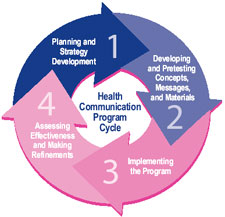|
Overview: The Health Communication Process
The Stages of the Health Communication Process
 For a communication program to be successful, it must be based on an understanding of the needs and perceptions of the intended audience. In this book, we incorporate tips on how to learn about the intended audience’s needs and perceptions in each of the program stages. Remember, these needs and perceptions may change as the project progresses, so be prepared to make changes to the communication program as you proceed. To help with planning and developing a health communication program, we have divided the process into four stages: Planning and Strategy Development; Developing and Pretesting Concepts, Messages, and Materials; Implementing the Program; and Assessing Effectiveness and Making Refinements. The stages constitute a circular process in which the last stage feeds back into the first as you work through a continuous loop of planning, implementation, and improvement. For a communication program to be successful, it must be based on an understanding of the needs and perceptions of the intended audience. In this book, we incorporate tips on how to learn about the intended audience’s needs and perceptions in each of the program stages. Remember, these needs and perceptions may change as the project progresses, so be prepared to make changes to the communication program as you proceed. To help with planning and developing a health communication program, we have divided the process into four stages: Planning and Strategy Development; Developing and Pretesting Concepts, Messages, and Materials; Implementing the Program; and Assessing Effectiveness and Making Refinements. The stages constitute a circular process in which the last stage feeds back into the first as you work through a continuous loop of planning, implementation, and improvement.
Use this book to produce and implement a plan for a communication program. The final plan will include the following components:
- General description of the program, including intended audiences, goals, and objectives
- Market research plans
- Message and materials development and pretesting plans
- Materials production, distribution, and promotion plans
- Partnership plans
- Process evaluation plan
- Outcome evaluation plan
- Task and time table
- Budget
Because this process is not linear, do not expect to complete a stage and then move to the next, never to go back.You will be exploring opportunities, researching issues, and refining plans and approaches as your organization implements the program. This ongoing, iterative process characterizes a successful communication program.
To help work through program planning and development, we suggest many steps within each stage.You may not find all of the steps suggested in each stage feasible for your program, or even necessary. As you plan, carefully examine available resources and what you want to accomplish with the program and then apply the steps that are appropriate for you. However, if you carefully follow the steps described in each stage of the process, your work in the next phase may be more productive.
Each of the four stages is described here; they are described in more detail in the subsequent sections of this book.
Stage 1: Planning and Strategy Development
In this book, all planning is discussed within the Planning and Strategy Development section, but the concepts you learn there apply across the life cycle of a communication program. During Stage 1 you create the plan that will provide the foundation for your program. By the end of Stage 1, you will have:
- Identified how your organization can use communication effectively to address a health problem
- Identified intended audiences
- Used consumer research to craft a communication strategy and objectives
- Drafted communication plans, including activities, partnerships, and baseline surveys for outcome evaluation
Planning is crucial for the success of any health communication program, and doing careful work now will help you avoid having to make expensive alterations when the program is under way.
Stage 2: Developing and Pretesting Concepts, Messages, and Materials
In Stage 2, you will develop message concepts and explore them with the intended audience using qualitative research methods. By the end of Stage 2, you will have:
- Developed relevant, meaningful messages
- Planned activities and drafted materials
- Pretested the messages and materials with intended-audience members
Getting feedback from intended audiences when developing messages and materials is crucial for the success of every communication program. Learning now what messages are effective with the intended audiences will help you avoid producing ineffective materials.
Stage 3: Implementing the Program
In Stage 3, you will introduce the fully developed program to the intended audience. By the end of Stage 3, you will have:
- Begun program implementation, maintaining promotion, distribution, and other activities through all channels
- Tracked intended-audience exposure and reaction to the program and determined whether adjustments were needed (process evaluation)
- Periodically reviewed all program components and made revisions when necessary
Completing process evaluations and making adjustments are integral to implementing the program and will ensure that program resources are always being used effectively.
Stage 4: Assessing Effectiveness and Making Refinements
In Stage 4, you will assess the program using the outcome evaluation methods you planned in Stage 1. By the end of Stage 4, you will have:
- Assessed your health communication program
- Identified refinements that would increase the effectiveness of future program iterations
Because program planning is a recurring process, you will likely conduct planning, management, and evaluation activities described in Stages 1–4 throughout the life of the program.
 Back to Top Back to Top
< Previous Section | Next Section > |